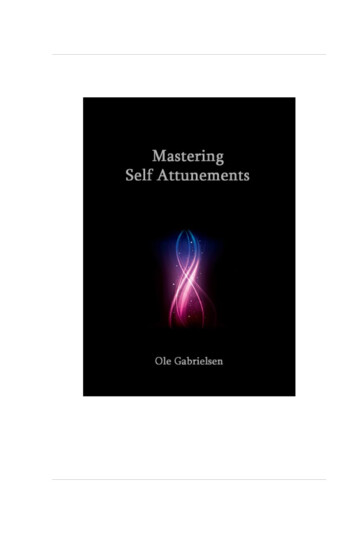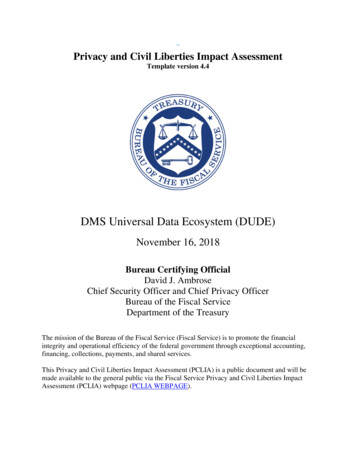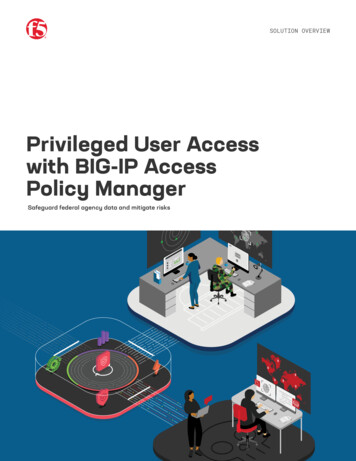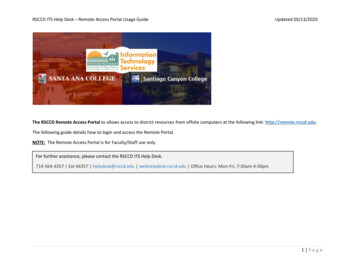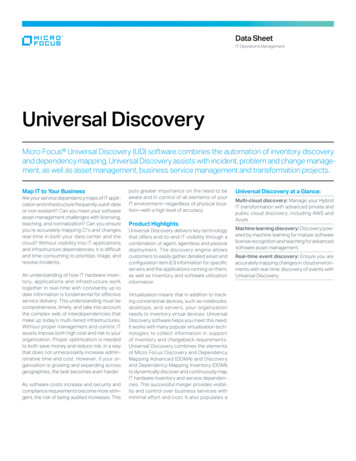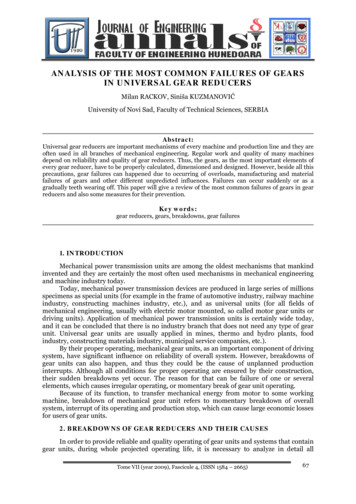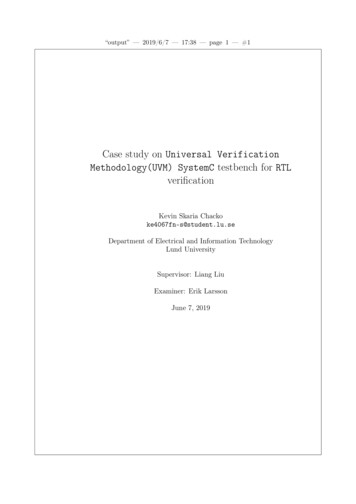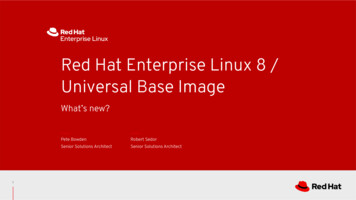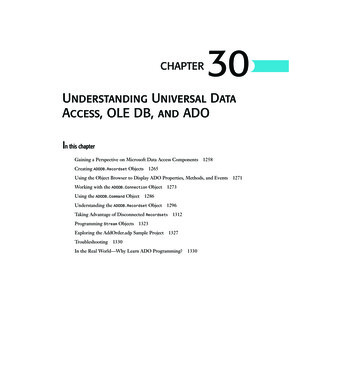
Transcription
38 0789729520 CH308/22/035:08 PMPage 1257CHAPTER30Understanding Universal DataAccess, OLE DB, and ADOIn this chapterGaining a Perspective on Microsoft Data Access ComponentsCreating ADODB.Recordset Objects12581265Using the Object Browser to Display ADO Properties, Methods, and EventsWorking with the ADODB.Connection ObjectUsing the ADODB.Command Object12731286Understanding the ADODB.Recordset Object1296Taking Advantage of Disconnected RecordsetsProgramming Stream Objects1323Exploring the AddOrder.adp Sample ProjectTroubleshooting131213271330In the Real World—Why Learn ADO Programming?13301271
38 0789729520 CH3012588/22/035:08 PMPage 1258Chapter 30 Understanding Universal Data Access, OLE DB, and ADOGaining a Perspective on Microsoft Data AccessComponents30Integrated data management is the key to Access’s success in the desktop RDBMS andclient/server front-end market. Access and its wizards let you create basic data-bound forms,reports, and pages with minimal effort and little or no VBA programming. Linked tablesprovide dynamic access to a wide range of data sources. As your Access applications growlarger and more complex, automation with VBA code in class and public modules becomesessential. When networked Access applications gain more users, performance may suffer as aresult of Jet record-locking issues or multiple connections to client/server back ends.Decreasing performance with increasing user load is a symptom of lack of scalability.Achieving scalability requires VBA code to manage your application’s database connections.This advanced chapter shows you how to write the VBA code that’s required to improve thescalability of Access front ends. You also learn how to use the Stream object to generateXML data documents from SQL Server 2000’s FOR XML AUTO queries.Access 2003 continues Microsoft’s emphasis on “Universal Data Access” for VBA and VisualBasic 6.0 programmers. Microsoft wants Access developers to abandon Jet’s Data AccessObjects (DAO), Access 97’s ODBCDirect, and the venerable Open Database Connectivity(ODBC) Application Programming Interface (API) in favor of a collection of ComponentObject Model (COM) interfaces called OLE DB and ActiveX Data Objects (ADO). Toencourage Access power users and developers to adopt OLE DB and ADO, all traditionalMicrosoft database technologies (referred to by Microsoft as downlevel or legacy, synonymsfor “obsolete”) are destined for maintenance mode. Maintenance mode is a technologicalpurgatory in which Microsoft fixes only the worst bugs and upgrades occur infrequently, ifever. In 1999, OLE DB, ADO, and, for Jet programmers, ActiveX Data Object Extensions(ADOX), became Microsoft’s mainstream data access technologies.Microsoft’s primary goals for Universal Data Access were to Provide the capability to accommodate less common data types unsuited to SQLqueries, such as directory services (specifically Active Directory), spreadsheets, emailmessages, and file systems Minimize the size and memory consumption of the dynamic link libraries (DLLs)required to support data access on Internet and intranet clients Reduce development and support costs for the multiplicity of Windows-based dataaccess architectures in common use today Extend the influence of COM in competition with other object models, primarilyCommon Object Request Broker Architecture (CORBA) and its derivativesThis chapter introduces you to the fundamentals of Universal Data Access and MicrosoftData Access Components (MDAC). MDAC makes connecting to databases with OLE DBpractical for Access users and developers. MDAC includes ADO and ADOX for conventional relational data, plus ADOMD for multidimensional expressions (MDX) to create andmanipulate data cubes.
38 0789729520 CH308/22/035:08 PMPage 1259Gaining a Perspective on Microsoft Data Access Components1259N OTEMicrosoft SQL Server Analysis Services (formerly OLAP Services) generates data cubesfrom online sources, such as transactional databases. Office 2003 installs Msadomd.dlland other supporting files for MDX and data cubes. Microsoft provides OLE DB for OLAPand the PivotTable Service to enable Excel 2003 PivotTables to manipulate data cubes.MDX and PivotTable services are beyond the scope of this book.Redesigning from the Bottom Up with OLE DBTo accommodate the widest variety of data sources, as well as to spread the gospel of COMand Windows XP/2000 ’s COM , Microsoft’s data architects came up with a new approachto data connectivity—OLE DB. OLE DB consists of three basic elements: Data providers that abstract information contained in data sources into a tabular (rowcolumn) format called a rowset. Microsoft currently offers native OLE DB dataproviders for Jet, SQL Server, IBM DB2, IBM AS/400 and ISAM, and Oracle databases, plus ODBC data sources. (Only Microsoft SNA Server installs the providers forIBM data sources.) Other Microsoft OLE DB providers include an OLE DB SimpleProvider for delimited text files, the MSPersist provider for saving and openingRecordsets to files (called persisted Recordsets), and the MSDataShape provider for creating hierarchical data sets. The MSDataShape provider also plays an important role inADP and when using VBA to manipulate the Recordset of Access forms and reports.TIPTo see the list of OLE DB data sources installed on your computer, open theNorthwindCS.adp project, and choose File, Get External Data, Link Tables to start the LinkTable Wizard. With the Linked Server option selected in the first dialog, click Next toopen the Select Data Source dialog, and double-click the Connect to New DataSource.odc file to open the second Wizard dialog. With the Other/Advanced itemselected in the data source list, click Next to open the Data Link Properties dialog. TheProviders page lists all currently installed OLE DB data providers. Click Cancel three timesto return to the Database window. Data consumers that display and/or manipulate rowsets, such as Access applicationobjects or OLE DB service providers. Rowset is the OLE DB object that ADO convertsto a Recordset object. Data services (usually called OLE DB service providers) that consume data from providersand, in turn, provide data to consumers. Examples of data services are SQL queryprocessors and cursor engines, which can create scrollable rowsets from forward-onlyrowsets. A scrollable cursor lets you move the record pointer forward and backward inthe Datasheet view of a Jet or SQL Server query.30
38 0789729520 CH3012608/22/035:08 PMPage 1260Chapter 30 Understanding Universal Data Access, OLE DB, and ADOFigure 30.1 illustrates the relationship between OLE DB data providers, data consumers,and data services within Microsoft’s Universal Data Access architecture. You should understand the relationships between these objects, because Microsoft commonly refers to themin ADO documentation, help files, and Knowledge Base articles. Database front ends written in C can connect directly to the OLE DB interfaces. High-level languages, such asVBA, use ADO as an intermediary to connect to OLE DB’s COM interfaces. Msado15.dll,which implements ADO 2.x, has a memory footprint of about 327KB, about 60% ofDao360.dll’s 547KB.30Figure 30.1This diagram showsthe relationshipsbetween front-endapplications, ADO andADOX, and OLE DBservice and dataproviders.Data ConsumersAccess 2000 Application ObjectsOLE DBAutomationWrapperC DatabaseFront-EndActiveX Data Objects (ADO)ADO Extensions (ADOX)OLE DBServiceProvidersSQL E DBJet SystemDirectoryServiceData ProvidersADO support files install in your \Program Files\System\Ado folder. If you’re runningWindows XP/2000 , the ADO support files are subject to Windows File Protection (WFP),which places a copy of the file in the DLL cache and prevents you from permanently deleting or moving the ADO support files. WFP also prevents unruly installation programs fromoverwriting the ADO support files with an earlier or corrupt (hacked) version.Some ADO 2.x support file names have a 1.5 version number, as in Msado15.dll; thestrange versioning of these files is required for backward compatibility with applicationsthat used very early versions of ADO.
38 0789729520 CH308/22/035:08 PMPage 1261Gaining a Perspective on Microsoft Data Access Components1261N OTEMDAC 2.x also supports Remote Data Services (RDS, formerly Advanced DatabaseConnector, or ADC). RDS handles lightweight ADOR.Recordsets for browser-basedapplications; RDS, which commonly is used for three-tier, Web-based applications, isrequired to make Data Access Pages (DAP) accessible safely over the Internet. For more information on the use of RDS with DAP, see “Enabling Private or Public Internet Access,”p. 1058.30Mapping OLE DB Interfaces to ADOYou need to know the names and relationships of OLE DB interfaces to ADO objects,because Microsoft includes references to these interfaces in its technical and white papers onOLE DB and ADO. Figure 30.2 illustrates the correspondence between OLE DB interfacesand the highest levels of the ADO hierarchy.Figure 30.2This diagram illustrates the correspondence between OLEDB interfaces andADO Automationobjects.OLE DB (C )ActiveX Data Objects OpenIOpenRowsetCreateSession( teCommand( )Open Rowset ( )ICommandExecute( etOpenIRowsetThe OLE DB specification defines a set of interfaces to the following objects:objects provide a set of functions to identify a particular OLE DB dataprovider, such as the Jet or SQL Server provider, and determine whether the caller hasthe required security permissions for the provider. If the provider is found and authentication succeeds, a connection to the data source results. DataSourceobjects provide an environment for creating rowsets and isolating transactions,especially with Microsoft Transaction Server (MTS), which runs under Windows NT.The COM components of Windows 2000 provide MTS services. Sessionobjects include sets of functions to handle queries, usually (but not necessarily)in the form of SQL statements or names of stored procedures. Command
38 0789729520 CH3012628/22/035:08 PMPage 1262Chapter 30 Understanding Universal Data Access, OLE DB, and ADOobjects can be created directly from Session objects or as the result of executionof Command objects. Rowset objects deliver data to the consumer through the IRowsetinterface. RowsetADO maps the four OLE DB objects to the following three top-level Automation objectsthat are familiar to Access programmers who’ve used ODBCDirect:objects combine OLE DB’s DataSource and Session objects to specify theOLE DB data provider, establish a connection to the data source, and isolate transactions to a specific connection. The Execute method of the ADODB.Connection object canreturn a forward-only ADODB.Recordset object. Connection30objects are directly analogous to OLE DB’s Command object. ADODB.Commandobjects accept an SQL statement, the name of a table, or the name of a stored procedure. Command objects are used primarily for executing SQL UPDATE, INSERT, DELETE, andSQL Data Definition Language (DDL) queries that don’t return records. You also canreturn an ADODB.Recordset by executing an ADODB.Command object. Commandobjects correspond to OLE DB’s Rowset objects and have properties andmethods similar to Access 97’s ODBCDirect Recordset. A Recordset is an in-memoryimage of a table or a query result set. RecordsetThe ADODB prefix, the short name of the ADO type library, explicitly identifies ADO objectsthat share object names with DAO (Recordset) and DAO’s ODBCDirect (Connection andRecordset). For clarity, all ADO code examples in this book use the ADODB prefix.TIPTo make ADOX 2.7 accessible to VBA, you must add a reference to Microsoft ADO Ext.2.7 for DDL and Security to your application. Access 2003 doesn’t add the ADOX reference automatically to new projects.Comparing ADO and DAO ObjectsFigure 30.3 is a diagram that compares the ADO and DAO object hierarchies. The ADOobject hierarchy, which can consist of nothing more than an ADODB.Connection object, ismuch simpler than the collection-based object hierarchy of DAO. To obtain a scrollable,updatable Recordset (dynaset), you must open an ADODB.Recordset object on an activeADODB.Connection object.Access VBA provides a DAO shortcut, Set dbName CurrentDB(), to bypass the first twocollection layers and open the current database, but CurrentDB() isn’t available in VBA codefor other members of Office 2003 or Visual Basic 6.0.
38 0789729520 CH308/22/035:08 PMPage 1263Gaining a Perspective on Microsoft Data Access ComponentsFigure 30.3ActiveX Data Objects (ADO)This diagram compares the ADO andDAO object Connection(Access Only)Data Access Objects (DAO)DBEngine(Jet 4.0)Workspaces CollectionActiveADODB.ConnectionWorkspace ObjectWorkspaces(0)Databases e eryDefs CollectionQueryDef ObjectQueryDef(n)DAO.RecordsetOpenN OTEAccess VBA provides a similar ADO shortcut, CurrentProject.Connection, whichpoints to a default ADODB.Connection object with the Jet OLE DB Service Provider forthe current database. Unlike CurrentDB(), which is optional, you must useCurrentProject.Connection as the ADODB.Connection to the currently opendatabase. If you try to open a new ADODB.Connection to the current database, youreceive a runtime error stating that the database is locked.Unlike DAO objects, most of which are members of collections, you use the New reservedword with the Set instruction to create and the Close method, the Set ObjectName Nothing, or both statements to remove instances of ADODB.Connection, ADODB.Command, andADODB.Recordset objects independently of one another. The Set ObjectName Nothinginstruction releases memory consumed by the object.DAO supports a variety of Jet collections, such as Users and Groups, and Jet SQL DataDefinition Language (DDL) operations that ADO 2.7 alone doesn’t handle. ADOX 2.7defines Jet-specific collections and objects that aren’t included in ADO 2.x. The “ProviderSpecific Properties and Their Values” section later in the chapter describes how to roll yourown cross-reference table to aid in migrating your DAO code to ADO.The most important functional difference between DAO and ADO is that ADO supportsWeb-based applications and DAO doesn’t. Thus, DAP bind to ADODB.Recordset objects.The continuing trend toward Internet-enabling everything means that Windows database
38 0789729520 CH3012648/22/035:08 PMPage 1264Chapter 30 Understanding Universal Data Access, OLE DB, and ADOprogrammers must make the transition from ODBC, ODBCDirect, RDO, and DAO technologies to ADO and OLE DB, so this book covers VBA programming of ADO, not DAO,objects. ADO supports ODBC connections to shared-file and client/server RDBMSs withthe Microsoft OLE DB Provider for ODBC (more commonly called by its beta code name,Kagera). ODBC introduces another layer into the database connection, so it’s less efficientthan OLE DB. The examples of this chapter use only native OLE DB providers.Upgrading from ADO 2.5 and Earlier to Version 2.6 ADO 2.x in this chapter refers collectively to ADO 2.1, 2.5, 2.6, and 2.7. Windows XP andOffice 2003 install ADO 2.7, which includes type libraries for ADO 2.0, 2.1, 2.5, 2.6 forbackward compatibility. Windows 2000 Service Pack (SP) 1 or later installs ADO 2.5 SP1,which includes type libraries for for prior versions. Installing the SQL Server 2000 DesktopEngine (MSDE2000) from the Office 2003 distribution CD-ROM—or any other version ofSQL Server 2000—upgrades Windows 2000’s ADO 2.5 to 2.6. Version 2.7 is required onlyto support Intel’s 64-bit Itanium processors. Upgrading from ADO 2.6 to 2.7 doesn’t addnew features or alter existing features.30N OTEAs mentioned in Chapter 27, “Learning Visual Basic for Applications,” the default VBAreference for new ADP is ADO 2.1 for Access 2000 database format. If you change thedefault database version to Access 2002 in the Options dialog, the reference changes toADO 2.5. Use of non-current references is required for backward compatibility withAccess 2000 and 2002 ADP. To review use of the VBA editor’s References dialog, see “References to VBA and Access Modules,”p. 1157.Following are the new or altered ADO objects, properties, and methods in ADO 2.6 :objects can contain fields defined as Recordsets, Streams of binary or text data,and child records of hierarchical Recordset objects. Use of Record objects is beyond thescope of this book. Recordobjects can send T-SQL FOR XML queries to SQL Server 2000 and return resultsets as XML documents. Stream objects also are used with the Record object to returnbinary data from URL queries executed on file systems, Exchange 2000 Web Folders,and email messages. The “Programming Stream Objects” section, near the end of thechapter, provides a simple example of the use of a Stream object to return XML datafrom a FOR XML T-SQL query to a text box. Stream
38 0789729520 CH308/22/035:08 PMPage 1265Creating ADODB.Recordset Objects1265objects gain new CommandStream and Dialect properties to support Streamobjects, and a NamedParameters property that applies to the Parameters collection. Commandand User ADOX objects add a Properties collection that contains Jet-specificProperty objects. This chapter doesn’t cover ADOX programming with VBA, becauseADOX applies only to Jet databases. GroupTIPIf you’re interested in learning more about ADOX, open the VBA Editor, type adox in theAsk a Question text box, select the ADOX methods option, click See Also in the “ADOXMethods” help page, and select ADOX API Reference in the list.Creating ADODB.Recordset ObjectsThe concept of database object independence is new to Access. The best way of demonstrating this feature is to compare DAO and ADO code to create a Recordset object froman SQL statement. DAO syntax uses successive instantiation of each object in the DAOhierarchy: DBEngine, Workspace, Database, and Recordset, as in the following example:Dim wsName As DAO.WorkspaceDim dbName As DAO.DatabaseDim rstName As DAO.RecordsetSet wsName DBEngine.Workspaces(0)Set dbName wsName.OpenDatabase (“DatabaseName.mdb”)Set rstName dbName.OpenRecordset (“SQL Statement”)As you descend through the hierarchy, you open new child objects with methods of the parent object.The most common approach with ADO is to create one or more independent, reusableinstances of each object in the Declarations section of a form or module:Private cnnName As New ADODB.ConnectionPrivate cmmName As New ADODB.CommandPrivate rstName As New ADODB.RecordsetN OTEThis book uses cnn as the object type prefix for Connection, cmm for Command, andfor Recordset. The cmm prefix is used because the cmd prefix traditionally identifies a command button control and the com prefix identifies the MSComm ActiveX control (Microsoft Comm Control 6.0).rstAlthough you’re likely to find references to DAO.Recordset dynasets and snapshots inthe Access documentation, these terms don’t apply to ADODB.Recordset objects. Seethe CursorType property of the ADODB.Recordset object in the “RecordsetProperties” section later in this chapter for the CursorType equivalents of dynasets andsnapshots.30
38 0789729520 CH301266308/22/035:08 PMPage 1266Chapter 30 Understanding Universal Data Access, OLE DB, and ADOAfter the initial declarations, you set the properties of the new object instances and applymethods—Open for Connections and Recordsets, or Execute for Commands—to activate theobject. Invoking the Open method of the ADODB.Recordset object, rather than theOpenRecordset method of the DAO.Database object, makes ADO objects independent of oneanother. Object independence and batch-optimistic lock
ADP and when using VBA to manipulate the Recordset of Access forms and reports. 30 NOTE Microsoft SQL Server Analysis Services (formerly OLAP Services) generates data cubes from online sources, such as transactional databases. Office 2003 installs Msadomd.dll and other supporting files f
